Working for Canadians
- Message from the President
- Reassurance
- Accuracy
- Safety
- High Standards
- Support
- Teamwork
- Certification
- Confidence
- Improvement
The Canadian Food Inspection Agency is dedicated to safeguarding food, animals and plants, which enhances the health and well-being of Canada's people, environment and economy.

Image collection of eight CFIA employees:
- Lynne Delorme, Quebec Laboratory Network – Administration
- Jean-Luc Michaud, Rimouski Office – Quebec Region Animal Health
- André Coderre, Animal Health – Estrie District – Office – Sherbrooke – St-Hyacinthe Region
- Jodi White, Consumer Protection Division
- Dr. Manjeet S Sethi, Pest Management Centre
- Rosette Fayez, Complex 3 – Toronto
- Carol Masters, Sidney Laboratory – Plant Viruses and Virus-like Diseases
- Mohamed Elmufti, Food Laboratory Program
The Canadian Food Inspection Agency
At the CFIA, we are proud of the contributions we make to the quality of life of Canadians.
If you have comments on this publication, we'd like to hear them. Contact us at:
WorkingforCanadians@inspection.gc.ca.
Message from the President

The CFIA celebrated its 15th anniversary in 2012. We are proud of our history but we are also looking to the future to meet the demands of a rapidly changing world.
The passage of the Safe Food for Canadians Act on November 22, 2012, allows us to take action on our legislative, regulatory and inspection framework and serve Canadians better. We're making more information available on our activities and decision-making processes. And we are strengthening our science capacity – the foundation for all we do.
Our job is to ensure industry produces safe food, help consumers make smart decisions, protect animal and plant health, and help Canadian agri-food products gain access to markets around the world.
We do this important work on behalf of all Canadians. We have profiled some of these activities to show how they result in health and economic benefits for our country.
Reassurance

Allergy alerts help keep Sarah's son safe
For Sarah Nicholl of Toronto, the CFIA spells reassurance. After a frightening episode that landed her son in intensive care when he was just seven months old, Sarah has relied on the CFIA's automated allergy alerts to help keep her son safe. Sarah's son has severe allergies to dairy, eggs, peanuts, tree nuts, and many kinds of fish. Consuming even a tiny amount of these would lead to potentially fatal anaphylactic shock. "The CFIA makes my shopping so much easier," says Sarah. "It's reassuring to know that the CFIA is there to enforce labelling requirements so I can trust what it says on the label. If there's an undeclared allergen in a product, I'll be notified immediately."
Protecting consumers
The CFIA's programs and services protect Canadians from preventable food safety hazards and ensure that food safety investigations are effectively managed. The CFIA also coordinates the majority of food recalls and allergy alerts in Canada.
Total Number of Food Recall Incidents
2011-2012
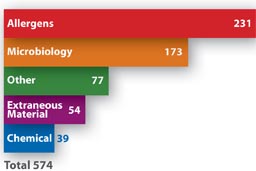
Descriptive text for graph:
In 2011-2012 there were 574 food recall incidents. 231 were caused by undeclared allergens, 173 by microbiological contamination, 77 by other contamination, 54 by extraneous material, and 39 by chemical contamination.Accuracy

Investments in science help protect Canadians
Fast, accurate testing is critical to preventing and minimizing the impact of an outbreak of food-borne illness. CFIA microbiology labs across Canada operate seven days a week, testing food samples collected by Agency inspectors. Stephen Norman, Director of the CFIA's Ottawa (Carling) laboratory, says the Agency also invests in research to improve its test methods. "Researchers in Ottawa, for example," says Stephen, "are working to develop methods to more quickly identify and characterize food-borne pathogens, including the types of E. coli that make people sick."
The Carling laboratory also tests animal feed and plant fertilizer. "Feed and fertilizer can carry contaminants like veterinary drugs, Salmonella or heavy metals into the human food chain," Stephen says. "It's another way we protect food safety."
Excelling as a science-based regulator
The CFIA performs over two million tests and analyses every year in its network of laboratories and through private labs accredited by the Agency. These tests include detection of microbial pathogens (see graph below), allergens, extraneous matter, toxins, pesticides and other contaminants in food, as well as the presence of disease and pests in plants and animals.
Food Microbiology Testing – Number of Samples
by Commodity 2011-2012
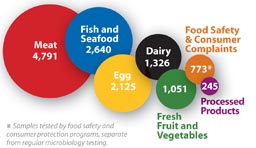
Descriptive text for graph:
In 2011-2012 food microbiology testing was carried out on 4791 samples of meat, 2640 fish and seafood samples, 2125 egg samples, 1326 dairy samples, 1051 fresh fruit and vegetable samples, and 245 processed product samples. 773 samples were tested due to food safety and consumer complaints.Safety

Allies in the development of safe, quality foods
Industrie gastronomique Cascajares prepared meals help restaurants save time and effort in their kitchens. Based in Saint-Hyacinthe, Quebec, Cascajares is a leader in supplying a variety of heat-and serve meat dishes.
"We are a federally-registered establishment, and the CFIA has been with us since we opened in Canada. We share the same objective: safe, high-quality products. Our Hazard Analysis and Critical Control Point (HACCP) co-ordinator says that the CFIA inspectors are here to help us improve – and she's absolutely right," says Janick Martin, General Manager at Cascajares.
Food safety is our top priority
Food safety is the Canadian Food Inspection Agency's top priority. In 2011-2012, food safety spending comprised approximately 45 per cent of the Agency's overall budget.
Federally Registered Establishments
2011-2012

Descriptive text for graph:
In 2011-2012 there were 2770 federally registered establishments in Canada. 759 were meat and poultry establishments, 729 were fish and seafood establishments, 280 were dairy establishments, 231 were egg establishments, 230 were maple product establishments, 230 were processed product establishments, 221 were honey establishments, and 90 were fresh fruit and vegetable establishments.High Standards

Training is part of our job
Canada has a world class meat production and inspection system. CFIA inspectors are present in all federally registered slaughter plants. Rommel Galzote, a Food Processing Specialist Inspector in the Greater Vancouver Area, covers everything from verifying company records and doing his own sampling to interviewing staff and observing production to make sure the required food safety procedures are implemented.
Rommel says keeping on top of new developments is a key part of his job, whether it's learning about new processing equipment or a new type of test. "Ongoing training helps us maintain Canada's high standards for food safety," says Rommel.
Inspectors working for Canadians
The work of inspectors is central to a modern, effective food safety system. Front line inspectors need up-to-date skills, an understanding of science and technologies, continuous training and modern information management tools to do their jobs.
CFIA Inspectors and Staff as of March 31, 2012
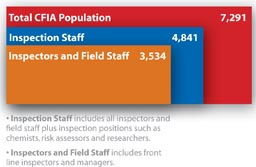
Descriptive text for graph:
As of March 31, 2012, the total CFIA population was 7291. 4841 of those were inspection staff and 3534 of those were inspectors and field staff.Support

CFIA support is indispensable to Canada's potato industry
The CFIA enforces measures to prevent the introduction and spread of potato diseases and pests, helping to protect both crops and access to foreign markets.
Potatoes grown by Les Fermes GAM Michaud Farms in Grand Falls, New Brunswick, are known for their freshness, quality and value. Says GAM co-owner Louise Désilets, "There is no room for error in export markets. The CFIA's support is indispensable. It makes our industry more competitive and reassures our buyers, which is key to our success." GAM has been working with the CFIA for eight years through the Canadian Partners in Quality Program, which helps to assure a high standard of quality across the industry.
Protecting Canada's plants, crops and forests
CFIA agrologists, biologists and inspectors carry out inspections and conduct surveys for plant pests and diseases. They also inspect and assess imports of plants, plant and forest products and soil to stop the entry of pests that could affect Canada's plant resource base and market access.
Total Food, Animal and Plant Import Shipments in Canada (by area)
2011-2012

Descriptive text for graph:
In 2011-2012 Canada received 2,422,289 food, animal and plant import shipments. 1,258,072 were received in Ontario, 757,453 in the West, 315,955 in Quebec, and 90,809 in the Atlantic area.Teamwork

The CFIA helps grow Canada's wood export markets
With its traditional market in the U.S. slowing down, Canada's wood industry is looking farther afield. Today, almost 40 percent of Canada's wood exports go overseas. Brian Zak, a British Columbia-based market access specialist with the Canada Wood Group – a coalition of wood industry associations – says cracking new markets takes teamwork: "We have governments, scientists, industry, the CFIA and others all working together."
Beyond making sure Canada's standards meet international requirements for phytosanitation – treating wood to eradicate insects or plant diseases – the CFIA is important to maintaining access to international markets. "The CFIA takes the lead if another country ever questions our phytosanitation standards or practices," says Brian.
Access for Canadian agri-food and forestry products
Export opportunities are critical for the growth of Canadian agriculture and agrifood and forestry industries. To support Canada's economic growth, the CFIA certifies that Canada's food, animal and plant exports meet the standards of importing countries.
Total Export Certificates Issued for Wood Products by Commodity
2011-2012
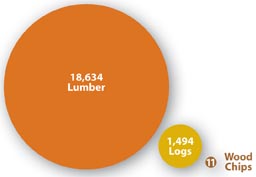
Descriptive text for graph:
In 2011-2012 18,634 export certificates were issued for lumber, 1,494 for logs and 11 for wood chips.Certification

Cattle exporter highlights CFIA role
Disastrous experiences with hoof and mouth disease and bovine spongiform encephalopathy have made the United Kingdom cautious about cattle imports. In fact, when 10 heifers from a farm near Edmonton arrived in the UK in 2010, they were the first live cattle admitted to that country in more than 20 years.
Barbara Gotaas, co-owner of Big Island Lowlines in Edmonton, says the CFIA helped make it possible. "The UK regulations were so new," says Barbara. "The CFIA got involved, consulted with their UK counterparts and figured out what we needed to do." Working with the CFIA, Big Island Lowlines achieved Canada Health Accredited Herd program certification. "It took a year to export the first cattle," says Barbara. "Thanks to our certification and the CFIA's guidance, our second shipment went much faster."
Safeguarding animal health
Animal diseases can wipe out entire herds. Some diseases can spread to humans. The CFIA controls animal and animal product imports, verifies that animal feed is safe, and takes action when disease outbreaks occur. Serious diseases are reported to the World Organisation for Animal Health.
Reportable Animal Diseases in Canada by Number of Herds/Flocks Affected
2011-2012

Descriptive text for graph:
In 2011-2012 there were 5 herds affected by scrapie, 2 by anaplasmosis, 2 by anthrax, 2 by chronic wasting disease, and 2 by bovine tuberculosis.Confidence

Destination Inspection Service maintains high standards
A shipment of fresh fruit or vegetables may travel thousands of kilometres to reach its destination – making it difficult to resolve disputes should the buyer question the quality of the shipment. To support a claim for compensation, the CFIA's Destination Inspection Service (DIS) will inspect the shipment and, for a fee, provide the buyer with a certified report on its condition.
DIS inspectors undergo three years of training to be ready to maintain the service's high standards for quality and consistency. Alain Dubuc, Inspector Lead Trainer at the CFIA's Montreal offices, says the results speak for themselves: "The industry has confidence in our procedures, verification systems and training program. Our certificates are the only ones recognized at face value in dispute resolution."
Inspecting for food quality
The CFIA regulates the import of food products. The Destination Inspection Service provides an impartial, quality-based inspection of fresh fruit and vegetables coming in to Canada.
Inspections of Imported Fresh Produce Shipments
2011-2012
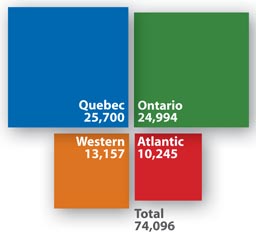
Descriptive text for graph:
In 2011-2012 there were 74,096 inspections of imported fresh produce shipments. 25,700 of these were in Quebec, 24,994 in Ontario, 13,157 in the West, and 10,245 in the Atlantic area.Improvement

Not all complaints at new CFIA office
At the CFIA's new Complaints and Appeals Office, it's all about turning a negative into a positive. "It's more than fielding complaints from stakeholders," says Director Dr. Kathy Scott. "Our reviews include looking at what the CFIA could have done differently."
Perhaps surprising, considering its name, the Office also receives a lot of compliments from stakeholders who've contacted the Office to say something good about service they've received from CFIA people. "In the past, stakeholders weren't even sure where to complain," Kathy says. "Our one-window approach is a real improvement - a place that will hear a complaint, look at it from both sides, and determine an outcome."
Moving forward: Building on our relationships
In February 2012, the CFIA introduced a Statement of Rights and Service for Producers, Consumers and Other Stakeholders. It describes the CFIA's commitment to:
- transparent decision making;
- accessible and timely information;
- fair, respectful and unbiased interactions with stakeholders; and
- responsiveness and continuous improvement.
We also now have a more accessible, transparent way to receive complaints, comments and compliments. The CFIA's Complaints and Appeals Office opened in April 2012.
Total Complaints, Compliments, Comments Received April-September 2012

Descriptive text for graph:
Between April and September 2012, the Complaints and Appeals Office received 34 compliments, 6 comments and 50 complaints. Of those complaints, 34 were closed by September 30, 2012.- Date modified: